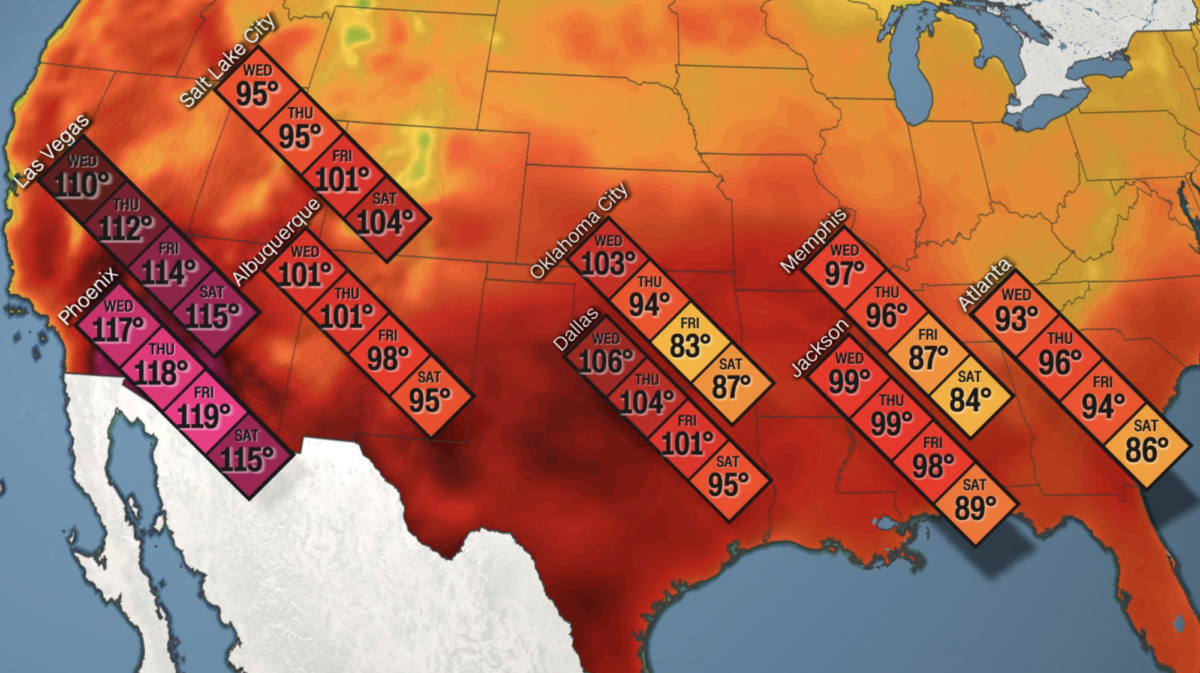The unprecedented heat wave sweeping across the United States has overwhelmed Atlantans, Westminster sports programs, and climate experts alike.
In recent weather reports, meteorologists have been using terms such as “humidity blanket” and “heat dome” to describe the extreme heat faced by Atlanta residents over the last 30 days. Scientific jargon aside, these terms hint at a rapidly worsening greenhouse effect — the tipping point for climate change that could be around the corner.
The Georgia High School Association (GHSA), the governing body of high school athletics statewide, instituted a new “Practice Policy for Heat and Humidity” for the five major fall sports: cheerleading, cross country, football, softball, and volleyball. According to the organization’s official memo, the policy “[follows] modified guidelines of the American College of Sports Medicine in regard to: (1) The scheduling of practices at various heat/humidity levels. (2) The ratio of workout time to time allotted for rest and hydration at various heat/humidity levels. (3) The heat/humidity levels that will result in practice being terminated.”
The GHSA’s benchmarks for determining heat and humidity levels revolve around the Wet Bulb Globe Temperature (WGBT) index. As per the guidelines for the 2023-2024 season, “WBGT readings should be taken every hour, beginning 30 minutes before the beginning of practice.” If the WBGT index peaks above 92.0, all outdoor activities remain prohibited, and unless the measurement dips under 90.0, the maximum practice time on any given day cannot exceed one hour (with a minimum of 20 minutes rest distributed throughout the practice duration).
Cross country coach Mitchell Griest has had to adapt to these guidelines while maintaining the appropriate standard of mileage for his runners.
“We’ve had to get in interval training in the early mornings, but now we’re happy to be training in the afternoon as it cools off.”
Alongside coaches Jason Vuckovic, Ricky Dimon, and head coach Joe Tribble, the team looks forward to the state meet in November as temperatures cool off.
“Over the course of the current heat wave, the average temperature has risen about a degree Fahrenheit,” explained Caitlin Wilson, an AP environmental science teacher and director of the Iceland travel program offered to Westminster’s rising sophomores.
Wilson also outlined the myriad of factors that exacerbate global warming, citing limited ocean absorption of heat among the chief culprits of the ongoing extreme weather event.
“Water has a specific heat capacity of 4.186 Joules per gram per degree Celsius, much greater than that of air (1.012 J/g°C),” said Wilson, “meaning it can absorb more heat per unit of mass than air can. The colder the oceans are, the more heat they can absorb from the atmosphere simply because the temperature difference is greater. The warmer they are, the less they are able to take in and retain.”
In this manner, our oceans’ ability to trap heat has decreased, allowing warmer air to circulate along coastlines.
Furthermore, Wilson described the “heat island effect,” a paradigm that goes hand in hand with urbanization in metropolitan areas such as downtown Atlanta and its suburbs.
“Heat islands are created when natural vegetated environments are replaced by surfaces like concrete in buildings and roadways that do not reflect or absorb heat in the same way,” said Wilson.
Compared to urban areas, forests act as far superior temperature regulators by providing shade, as well as through the process of evapotranspiration.
“In evapotranspiration,” Wilson described, “trees and other plants take in water through their roots and transpire it out into the atmosphere as water vapor through their leaves. This acts like a mister on a hot day, cooling organisms around it.”
Simply put, more trees and greenery in our surroundings could work to alleviate the stresses imposed by climate change on our local temperatures.
Wilson also listed altered bird migration patterns as a tangible effect of global warming on ecosystems and wildlife. The dates of migration, tracked by ornithologists and other scientists, have been trending earlier and earlier in the year, leaving experts to believe that summertime temperatures have eclipsed the habitable zone for these avian species’ heat tolerance.
“I would love to see the full conversion of fossil fuel energy systems to renewable sources,” said Wilson, when asked about Iceland’s sustainability regimes and how they could inform the implementation of preventative measures on the homefront.
“There’s an abundance of resources on the geographic east coast available for renewable use in our power grids: wind, solar, hydroelectric, and even geothermal in certain hotspots,” Wilson said, “although we can’t make use of geothermal [energy] like Iceland does.”
For those passionate about the environment and taking a stand against climate change, the Eco-Club provides an opportunity for service and advocacy to Upper School students.
“The past few years we’ve been trying to get recycling back since the recycling bins placed around campus are used as regular trash cans. We need the entire student body to contribute to the cause and take responsibility, as the main reason why the school isn’t recycling is because people aren’t sorting their trash out properly,” said Claire Kim, one of the club’s three leads.
“I used to live in Missouri,” said Kim. “Its geography consists mostly of flat prairie regions and it has a large grasshopper population, or it used to. In fourth grade, I started noticing how there was a significant decline in the grasshopper numbers compared to when I first moved there.”
From this observance, Claire developed a passion for preserving the environment, and now more than ever, spreading awareness is crucial.
As this crisis deepens, the question of the hour becomes more apparent: has our society reached a point of no return in terms of global habitability and climate change?
Wilson offered her take on the present situation in the context of the current heat wave. She stated primarily that it is difficult to tell when the point of no return may be but that there is research on nine planetary boundaries which have been identified as critical to healthy living conditions for all organisms. The nine boundaries are stratospheric ozone depletion, biodiversity loss and extinctions, chemical pollution, climate change, ocean acidification, freshwater consumption, land change, nitrogen and phosphorous flows to the ocean, and atmospheric aerosol loading.
“As you can see, climate is just one of the nine major categories that life on earth depends on,” said Wilson. “These researchers estimate that climate change has not yet passed the ‘tipping point’ to where earth systems are severely disrupted, but that it is heading in that direction and that we are currently in a zone of uncertainty.”
Edited by Ayan Chaganthi




